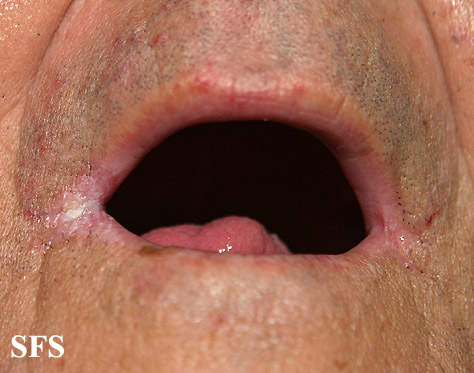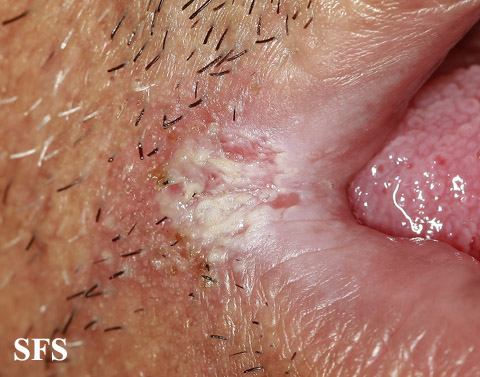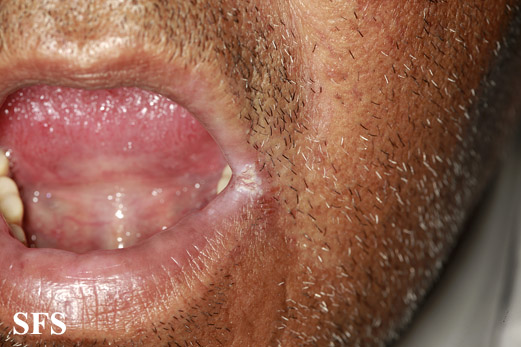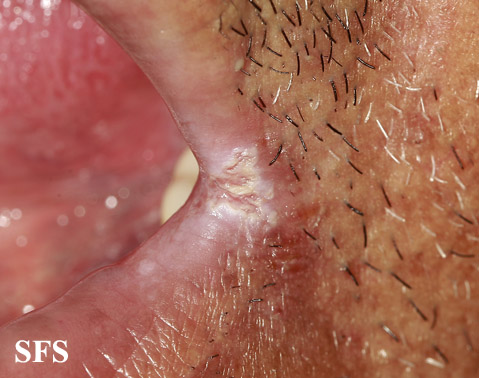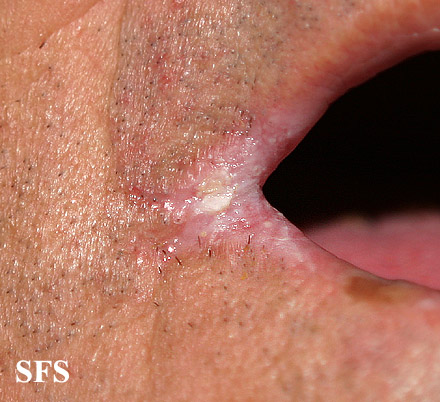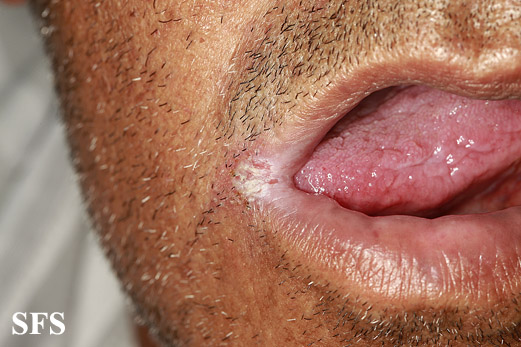Angular cheilitis
|
WikiDoc Resources for Angular cheilitis |
|
Articles |
|---|
|
Most recent articles on Angular cheilitis Most cited articles on Angular cheilitis |
|
Media |
|
Powerpoint slides on Angular cheilitis |
|
Evidence Based Medicine |
|
Cochrane Collaboration on Angular cheilitis |
|
Clinical Trials |
|
Ongoing Trials on Angular cheilitis at Clinical Trials.gov Trial results on Angular cheilitis Clinical Trials on Angular cheilitis at Google
|
|
Guidelines / Policies / Govt |
|
US National Guidelines Clearinghouse on Angular cheilitis NICE Guidance on Angular cheilitis
|
|
Books |
|
News |
|
Commentary |
|
Definitions |
|
Patient Resources / Community |
|
Patient resources on Angular cheilitis Discussion groups on Angular cheilitis Patient Handouts on Angular cheilitis Directions to Hospitals Treating Angular cheilitis Risk calculators and risk factors for Angular cheilitis
|
|
Healthcare Provider Resources |
|
Causes & Risk Factors for Angular cheilitis |
|
Continuing Medical Education (CME) |
|
International |
|
|
|
Business |
|
Experimental / Informatics |
Editor-In-Chief: C. Michael Gibson, M.S., M.D. [1];Associate Editor(s)-in-Chief: Aakash Hans, MD[2]
Overview
Angular cheilitis (also called perlèche, cheilosis, or angular stomatitis) is an inflammatory lesion at the labial commissure or corner of the mouth and often occurs bilaterally. The condition manifests as deep cracks or splits. In severe cases, the splits can bleed when the mouth is opened and shallow ulcers or a crust may form. It usually occurs due to an underlying condition as the main cause. As the condition is generally mild, it has the propensity to go unnoticed for long periods of time. Identifying the underlying etiology is essential to decide the appropriate treatment. Altered structures of the mouth lead to an approximation of the lips which causes pooling of the saliva at the angles of the mouth. It also presents as part of syndromes, especially those related to micro-nutrient deficiencies. Therefore, even after diagnosis, further testing should be done to rule out any underlying abnormalities which could later turn more sinister. The condition itself is manageable, resolves within two weeks if treatment is initiated on time, and poses little to no risk to life. It rarely causes permanent disfigurement but it is notorious for recurrence if the contributing factors like oral health and denture care are not maintained hygienically or when treatment is taken inadequately. Ill-fitting dentures are also a common recurring cause of angular cheilitis.
Historical significance
- The word cheil is a Greek word for lips and itis means inflammation. Angular cheilitis is the inflammation of the corners of the mouth, where the skin and the mucosa meet. It can be associated with redness, formation of crust, and the skin appearing wet and soggy to touch due to long contact of the skin with moisture.
- In the year 1886, Leimastre gave it the name perléche which means to lick in French after inducing that several people with this condition had the predilection to lick the affected area. [1][2]
- Finnerud noticed that members of the same family were affected more often, which made him considered infectious spread as a possible etiology. [3]
- In 1986 Ohman et al deduced a system to classify and stage the progress of angular cheilitis. [4]
Causes
Various etiologies are involved and often an interplay of all the factors is seen.
- Infections: Majority of the cases are due to combination of the microorganisms mentioned below. Out of these, candida and staphylococcus have the potential to be the sole cause of infection.[5]
- Fungal: Candida is normally present in the oral cavity, but in its yeast form, which is non-pathogenic. Poor oral hygiene, dentures and uncontrolled diabetes are responsible for candida turning into its hyphal form (pathogenic) and increasing its number of colonies in the mouth. Subsequently the candida erodes the commissures, setting foundation for additional bacterial infection.[6]
- Bacterial : Within the anterior portion of the nose, resides Staphylococcus aureus, which is another common cause of infection, given its proximity to the commissures. Streptococci is also prevalent in the nares and hence is occasionally isolated as cause of infection.
- Systemic diseases: The inability to absorb vital nutrients as a result of bowel inflammation, the healing processes get adversely affected in individuals with inflammatory bowel disease which in turn play a significant role in the development of cheilitis.
- Characterized by decreased salivary gland function and dry mouth, Sjögren's syndrome predisposes to angular cheilitis. Contrary to the pre-established pathophysiology of excess saliva being detrimental to the commissure, low levels of saliva is also damaging as it provides the lubrication to reduce friction at the commissures.[7]
- Atopic dermatitis: Any allergy or irritant to the commissural skin has the possibility of causing angular cheilitis. Dental braces, mouthwash, lipsticks, toothpaste, and foods with certain flavors and chemicals preservatives, all are potentially capable of rendering chronic irritation at these skin folds.[8]
- Micronutrient deficiency: Ranges from protein deficiency to iron, Vitamin B2, B9 and B12 and zinc deficiency.
- Recurrent insults to the angle of mouth: Aggressive dental flossing, licking the commissures, sucking lollipops and candy and some medications like isotretinoin and certain chemotherapeutic drugs make the angles of the mouth more susceptible to inflammation followed by infection.
Epidemiology
- Although the prevalence is only approximately 7 out of 1000 individuals in the US, angular cheilitis is the most common form of lip infections (bacterial/fungal). It is more common in certain groups which are at a greater risk.
- These include persons who wear dentures, with certain conditions like inflammatory bowel disease, HIV-positive individual and other immunodeficiency states.
- Children and adults between 30-60 years are more frequently affected by angular cheilitis. [9]
Pathophysiology
- The most well-understood mechanism behind angular cheilitis is the continuous exposure of the angles of the mouth to saliva.[10]
- It may seem harmless, but saliva has various enzymes which when left for a prolonged period on the skin, can cause erosion and eventually weaken the physical barrier and integrity of the skin covering the angle of the mouth.
- This in turn makes the area vulnerable to higher chances of infection by various micro-organisms. Another factor is the angle of the mouth acting as a transition zone between the squamous epithelium of the face and the epithelium lining the oral cavity.
- It experiences increased amounts of shearing and frictional forces when the mouth opens and closes. These factors act together to weaken the commissures and provide an inlet for chemicals and infections to further damage the area.
Diagnosis
History
- The patient may have a history of past use of dentures or any dental surgical procedures.[11]
- As angular cheilitis usually occurs as part of a syndrome, a detailed history of any symptoms of systemic problems should be enquired.
- Patients of Crohn’s disease may present with cheilitis as a primary complaint but may also have associated diarrhea, pain in the abdomen, and blood mixed stools.
- Similarly, problems of dryness in the eyes and oral cavity may also be associated with angular cheilitis in patients with Sjogren’s syndrome.[12]
- Pain may or may not be present, rather the patient will complain of changed sensation near the corners of the mouth like dryness, soreness, or itchiness.
- If the patient has a history of any condition which may compromise his or her immune system like diabetes, AIDS, or use of steroids, thrush would be prevalent in these groups.
- Symptoms
- Redness at corners of the mouth
- Itchiness or dryness at the commissure
- Pain or altered skin sensation at the angle of mouth
- Burning sensation
- Physical examination
- Angles of the mouth appear red and swollen with triangular lesions limited to the commissures in mild cases.
- Unless there are factors unequally affecting one side over the other, angular cheilitis lesions are commonly seen on both sides.
- Chronic inflammation can cause the formation of fissures which follows the natural path of saliva flow to form, along the marionette lines.
- The oral mucosa should also be examined to detect oral thrush, which if present, should be treated.
- Investigations : Based on the impression about the possible cause, investigation should confirm the initial diagnosis.
Staging
The disease was classified according to the appearance of its lesions by Ohman et al. Staging can be utilized to keep in check with the progress of ongoing treatment and helps in deciding the aggressiveness of treatment required according to the severity.[4]
- Type I: Small cracks in the skin limited to the angle of mouth with slight involvement of surrounding skin.
- Type II: Borders with greater length and depth as compared to Type I.
- Type III: Increased number of cracks and fissures extending from the angles of the mouth into the skin.
- Type IV: No cracks or fissures but erythematous skin becomes contagious to the border between the skin and the lips.
Treatment
A multifaceted approach is used for successfully treating the condition, with attention given to both infectious and non infectious factors.[13][14]
- Common initial measures
- Look for signs of infection and treat appropriately when diagnosed.
- Encourage oral hygiene.
- Maintain prosthesis hygiene.
- Evaluate if the prosthesis size or shape is causing any discomfort.
- Look for salivary issues of decreased or increased salivary production.
- Advise use of new toothbrushes and discard the older ones if the cause was infectious.
- Eliminate lip licking.
- Ask to avoid smoking.
- Ensure glycemic control if patient is diabetic.
- Initiate anti-retroviral treatment if AIDS is detected.
- Supplementation in case of deficiency of an essential nutrient.
- Topical barrier application
- In non-infectious cases, where pooling of saliva is the main concern, the angles of the mouth need to be protected from the macerating effect of saliva.
- Lip balm, emollients or petroleum based jelly can be used.[15]
- Topical antifungals
- Ketoconazole cream (2 %)
- Gentian violet preparation
- Miconazole (2 %)
- Nystatin (1,00,000 units/ml)
- Clotrimazole (1 percent)
- Systemic antifungals
- Nystatin suspension (1,00,000 units/ml)
- Fluconazole (100-200mg)
- Itraconazole (200mg)
- Voriconazole
- Topical antibiotics
- Mupirocin (2 %) preparation
- Fusidic acid (2 %)
- Systemic antibiotics
- These are seldom required and are prescribed according to culture sensitivity reports.
- Topical steroids
- Hydrocortisone (1 %)
- Desonide (0.05 %)
References
- ↑ Budtz-Jørgensen E (1981) Oral mucosal lesions associated with the wearing of removable dentures. J Oral Pathol 10 (2):65-80. DOI:10.1111/j.1600-0714.1981.tb01251.x PMID: 6792333
- ↑ Lemaistre J. Etude sur Fair de la vile de Lemerges de la perleche: Du Streptococcus plicatilis.
- ↑ Finnerud CW. Perleche : Its nosologic status JAMA 1944;126:737-40
- ↑ 4.0 4.1 Ohman SC, Dahlén G, Möller A, Ohman A (1986). "Angular cheilitis: a clinical and microbial study". J Oral Pathol. 15 (4): 213–7. doi:10.1111/j.1600-0714.1986.tb00610.x. PMID 3088236.
- ↑ MacFarlane TW, Helnarska SJ (1976). "The microbiology of angular cheilitis". Br Dent J. 140 (12): 403–6. doi:10.1038/sj.bdj.4803773. PMID 1067101.
- ↑ Sharon V, Fazel N (2010). "Oral candidiasis and angular cheilitis". Dermatol Ther. 23 (3): 230–42. doi:10.1111/j.1529-8019.2010.01320.x. PMID 20597942.
- ↑ Błochowiak K, Olewicz-Gawlik A, Polańska A, Nowak-Gabryel M, Kocięcki J, Witmanowski H; et al. (2016). "Oral mucosal manifestations in primary and secondary Sjögren syndrome and dry mouth syndrome". Postepy Dermatol Alergol. 33 (1): 23–7. doi:10.5114/pdia.2016.57764. PMC 4793060. PMID 26985175.
- ↑ Yesudian, P. D.; Memon, A. (2003). "Nickel-induced angular cheilitis due to orthodontic braces". Contact Dermatitis. 48 (5): 287–288. doi:10.1034/j.1600-0536.2003.00097.x. ISSN 0105-1873.
- ↑ Sonis AL (2005). "The prevalence of oral mucosal lesions in United States adults: data from the Third National Health and Nutrition Examination Survey, 1988-1994". J Evid Based Dent Pract. 5 (3): 166–7. doi:10.1016/j.jebdp.2005.06.011. PMID 17138365.
- ↑ Warnakulasuriya KA, Samaranayake LP, Peiris JS (1991). "Angular cheilitis in a group of Sri Lankan adults: a clinical and microbiologic study". J Oral Pathol Med. 20 (4): 172–5. doi:10.1111/j.1600-0714.1991.tb00915.x. PMID 2061855.
- ↑ Cross D, Eide ML, Kotinas A (2010). "The clinical features of angular cheilitis occurring during orthodontic treatment: a multi-centre observational study". J Orthod. 37 (2): 80–6. doi:10.1179/14653121042930. PMID 20567030.
- ↑ Serrano J, Lopez-Pintor RM, Gonzalez-Serrano J, Fernandez-Castro M, Casanas E, Hernandez G (2018). "Oral lesions in Sjogren's syndrome: A systematic review". Med Oral Patol Oral Cir Bucal. 23 (4): e391–e400. doi:10.4317/medoral.22286. PMC 6051685. PMID 29924754.
- ↑ "StatPearls". 2021. PMID 30725614.
- ↑ Kahana M, Yahalom R, Schewach-Millet M (1986). "Recurrent angular cheilitis caused by dental flossing". J Am Acad Dermatol. 15 (1): 113–4. doi:10.1016/s0190-9622(86)80145-1. PMID 3722500.
- ↑ Peltola P, Vehkalahti MM, Wuolijoki-Saaristo K (2004). "Oral health and treatment needs of the long-term hospitalised elderly". Gerodontology. 21 (2): 93–9. doi:10.1111/j.1741-2358.2004.00012.x. PMID 15185989.
